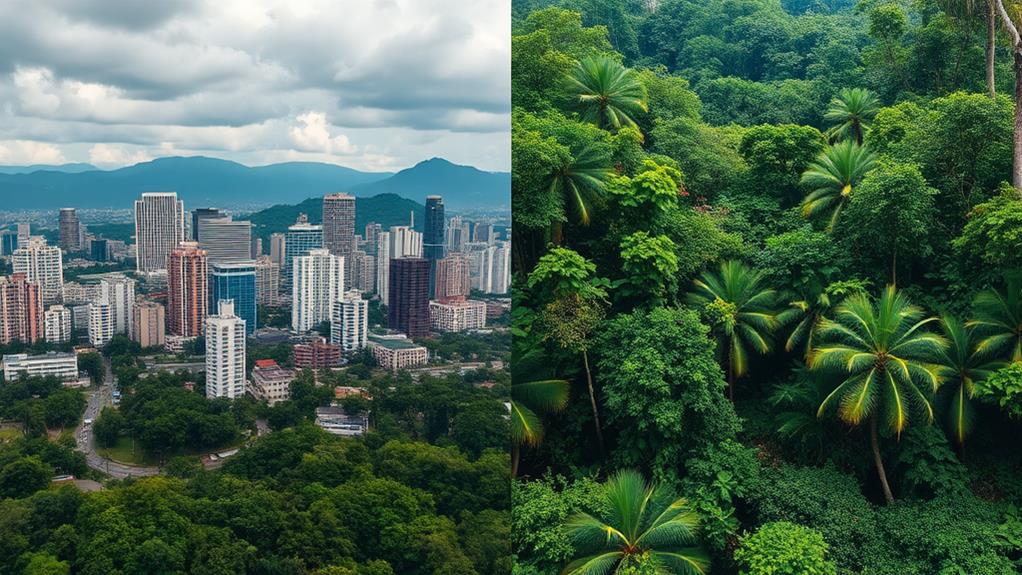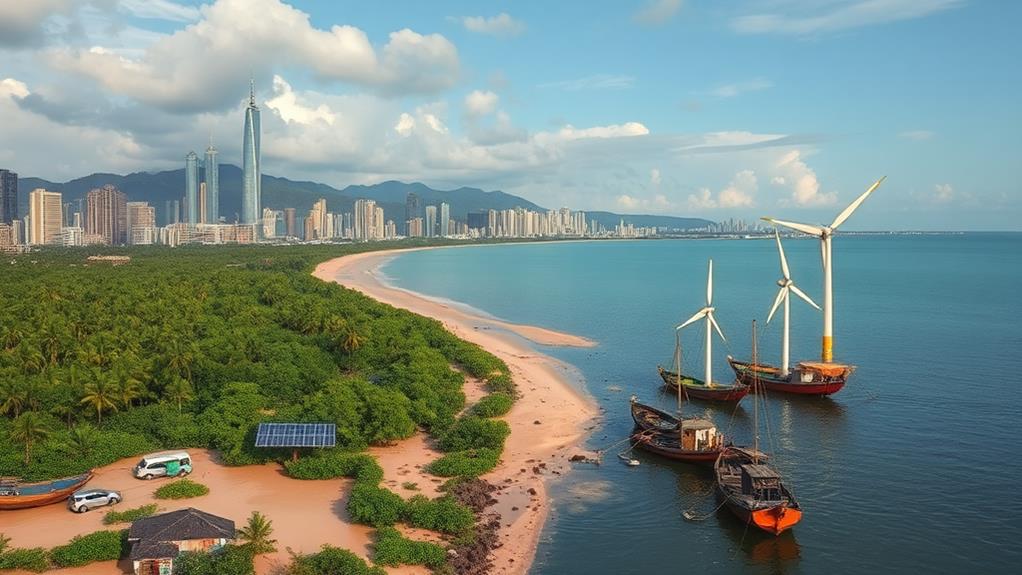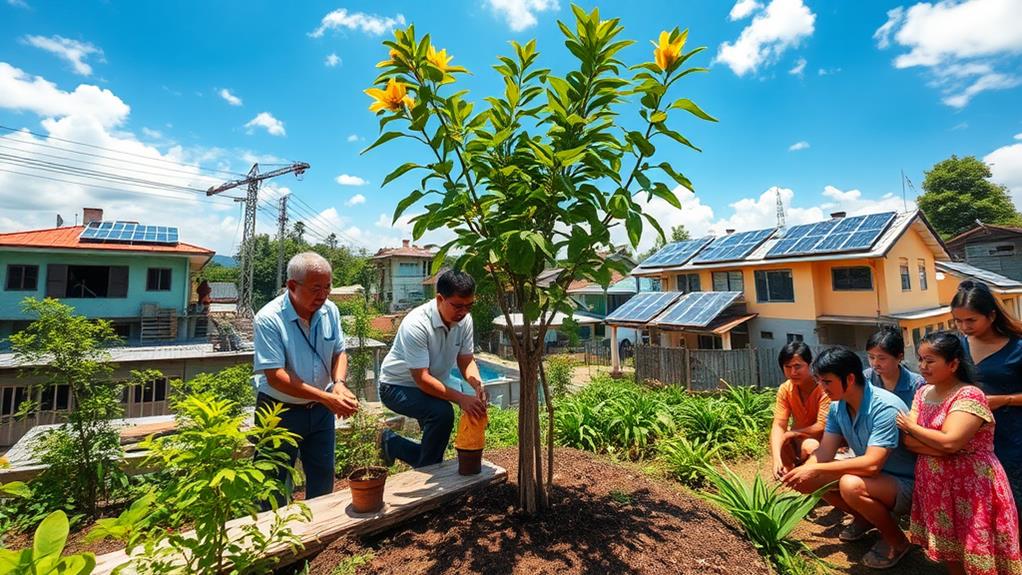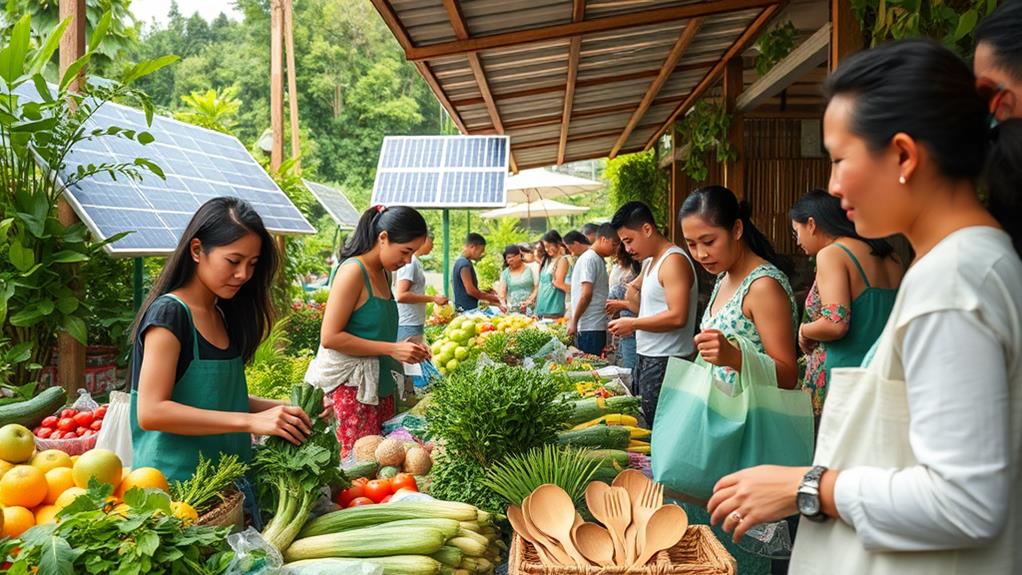Balancing economic development with environmental sustainability in the Philippines requires a focus on renewable energy and eco-friendly practices.
Currently, over 70% of electricity comes from fossil fuels, which cause pollution and greenhouse gas emissions. The Renewable Energy Act aims for 15% renewable energy by 2030, but more efforts are needed to reach this goal.
To improve sustainability, sustainable agriculture practices should be adopted. For example, using organic farming techniques can reduce chemical runoff into rivers.
Additionally, restoring mangroves helps protect coastlines and supports biodiversity. Corporate responsibility is also essential; companies can implement greener policies to lessen their environmental impact.
The public generally supports environmental initiatives, which provides a strong base for change.
By including sustainability in economic plans, we can work toward a healthier future for the Philippines.
Importance of Energy in Development

Energy is essential for the economic development of the Philippines. It powers industries, homes, and drives innovation. Currently, over 70% of electricity comes from fossil fuels like coal and oil. In 2019, the country relied heavily on petroleum for 45% and coal for 36% of its energy. In contrast, only 7% of energy came from renewable sources. This shows a clear need to diversify energy sources to include more renewables.
The Renewable Energy Act of 2008 requires that 15% of the country's energy comes from renewable sources by 2030. This demonstrates the government's focus on sustainable energy.
To meet this goal, it's important to invest in clean energy technologies. These investments are necessary for reducing carbon emissions and addressing environmental issues.
Improving energy efficiency is also important. It can lead to greater productivity.
Affordable and sustainable energy helps keep prices down and boosts consumer spending, which supports economic growth. Therefore, tackling energy challenges is crucial for the Philippines to create a balanced and sustainable economy.
Economic Growth vs. Environmental Protection
Balancing economic growth and environmental protection is a major challenge for the Philippines. The country aims to increase its GDP, but relies on fossil fuels for over 70% of its electricity, leading to high greenhouse gas emissions and pollution. This creates a conflict between wanting to grow the economy and needing to protect the environment.
- Energy Sector: The Renewable Energy Act of 2008 requires that 15% of energy comes from renewable sources by 2030. However, the current reliance on fossil fuels makes it difficult to meet these environmental goals.
- Deforestation: Activities like agricultural expansion and building infrastructure are causing a loss of natural forests. This results in the release of 22.5 million metric tons of CO₂, harming biodiversity and worsening climate change.
- Urban Pollution: Air quality is poor in cities due to vehicle emissions. The average level of fine particulate matter is 24 µg/m³, which exceeds WHO safe limits.
To tackle these challenges, the Philippines needs a plan that combines economic growth with strong environmental protections. This balance is crucial for a sustainable future.
Key Environmental Challenges

The Philippines faces serious environmental problems that harm its ecosystems and people's health. One major issue is the 2.7 million tons of plastic waste produced each year, which leads to marine pollution and puts marine life at risk.
Additionally, air quality in cities is poor due to high levels of fine particulate matter, which can cause health issues for residents.
Deforestation is another critical challenge, with forest areas decreasing from 13.2 million hectares in 2010 to 12.9 million hectares in 2021. This loss contributes to higher carbon dioxide levels in the atmosphere.
The country is also experiencing the effects of climate change, including a 60 cm rise in sea level, which is three times the global average, threatening coastal communities and farming.
Lastly, the Philippines gets over 70% of its electricity from fossil fuels, increasing greenhouse gas emissions.
To address these problems, it's essential to adopt sustainable practices. Policymakers should focus on programs that promote waste reduction, enhance air quality, and support a shift to renewable energy sources. This will help create a healthier environment for future generations.
Impact of Deforestation
Deforestation in the Philippines is a serious problem that affects the environment and local communities. The forest area has decreased from 13.2 million hectares in 2010 to 12.9 million in 2021. This loss has caused 22.5 million metric tons of carbon emissions, which contribute to climate change and hinder efforts for a sustainable economy.
Here are three major impacts of deforestation:
- Biodiversity Loss: Deforestation destroys the homes of endangered species, like the Philippine Eagle, leading to fewer animals and plants in the ecosystem.
- Soil Erosion: Without trees, soil becomes loose and washes away more easily. This results in land degradation, making it harder to grow crops and decreasing agricultural productivity.
- Community Displacement: Indigenous peoples rely on forests for their survival. When forests are cut down, these communities often lose their homes and cultural heritage, which increases their vulnerability.
To address these challenges, we need stronger laws against illegal logging and mining.
Climate Change Vulnerabilities

Climate change vulnerabilities in the Philippines are severe. Sea levels have risen by 60 cm, which is three times the global average. This rise threatens coastal communities by increasing risks such as coastal erosion and saltwater intrusion.
These issues make it harder for farmers to grow food and maintain food security.
Natural disasters are becoming more frequent. Communities in low-lying areas are at risk from storms and typhoons, which can displace families and put more pressure on local resources.
Food security is impacted by climate change. Higher temperatures and extreme weather make it difficult for farmers to produce enough food.
Additionally, saltwater intrusion affects freshwater supplies, making water less available in coastal areas.
To combat these challenges, the Philippines needs to lower carbon emissions. The country currently relies on fossil fuels for over 70% of its electricity.
Switching to renewable energy sources and encouraging sustainable farming practices are essential steps.
Current Energy Consumption Trends
The Philippines heavily relies on fossil fuels for its energy needs, which is a major challenge for sustainable development. Over 70% of the country's electricity comes from fossil fuels, mainly coal, oil, and natural gas. This dependency leads to high greenhouse gas emissions.
In 2019, the breakdown of energy consumption was as follows:
- Petroleum: 45%
- Coal: 36%
- Natural Gas: 7%
- Renewable Sources: 7%
The Renewable Energy Act of 2008 aims to increase the share of renewable energy to 15% by 2030. Although fossil fuels dominate now, there are positive signs.
Companies like Globe Telecom and Ayala Land are investing in clean energy technologies. Public support for environmental efforts is strong, with 88.7% of Filipinos wanting businesses to act responsibly and 91.8% believing individual actions can help the environment.
These trends highlight the need for policies that encourage sustainable energy practices and decrease reliance on fossil fuels, moving the Philippines towards a cleaner energy future.
Government Initiatives for Sustainability

The Philippine government is working to move away from fossil fuels and adopt sustainable practices. One key initiative is the Renewable Energy Act of 2008, which sets a goal for at least 15% of the energy mix to come from renewable sources by 2030. This law helps promote the use of cleaner energy and emphasizes the importance of protecting the environment.
Another important plan is the National Climate Change Action Plan, which includes strategies for adapting to and reducing the effects of climate change. This plan helps improve resilience and supports sustainability in different sectors.
For instance, the government's programs to restore mangroves and coral reefs are crucial for protecting biodiversity and coastal areas.
The government also encourages businesses to adopt eco-friendly practices. A significant 88.7% of Filipinos support corporate environmental responsibility.
To further promote sustainability, the government collaborates with local groups to advance sustainable agriculture and renewable energy, highlighting the importance of community involvement.
Through these efforts, the government aims to create a sustainable future while balancing economic growth and environmental protection.
How Can Economic Development be Balanced with Environmental Sustainability in the Philippines’ Tourism Industry?
Balancing economic development with environmental sustainability in the Philippines’ tourism industry is crucial for the long-term success of sustainable tourism in the philippines. This can be achieved through responsible infrastructure development, promoting eco-friendly practices, and enforcing strict regulations to protect the country’s natural resources and biodiversity.
Corporate Responsibility in Energy
In the Philippines, over 70% of electricity comes from fossil fuels, highlighting the importance of corporate responsibility in moving towards renewable energy.
The Renewable Energy Act of 2008 requires that 15% of energy must come from renewable sources by 2030. Companies are actively working to meet this requirement.
Here are three ways companies can show responsibility in energy:
- Invest in Renewable Projects: For example, Globe Telecom and Ayala Land are investing in clean energy projects that help lower their carbon emissions.
- Enhance Energy Efficiency: San Miguel Corporation has improved its energy efficiency, demonstrating a commitment to sustainable practices that also cut down costs.
- Engage Stakeholders: A survey found that 88.7% of Filipinos believe that companies should take action for the environment.
This shows strong public support for corporate responsibility in energy sustainability.
Role of Consumers in Sustainability

Consumers are very important in the movement towards sustainability. In the Philippines, 88.7% of people support companies taking active steps to protect the environment. This shows that what you prefer as a consumer really matters. Many people are changing their buying habits; 66.3% of Filipinos have recently bought eco-friendly products. This shows a clear demand for sustainable options.
| Consumer Insights | Percentage (%) |
|---|---|
| Support for corporate environmental measures | 88.7 |
| Belief in individual impact | 91.8 |
| Purchases of eco-friendly products | 66.3 |
Knowing your ecological footprint is key. When you choose sustainable and inclusive products, you help create demand. This, in turn, encourages companies to use renewable energy and sustainable materials. Your decisions are vital for promoting a culture of sustainability that can affect both businesses and government policies. As you continue to support responsible choices, your voice will help build a more sustainable future for the Philippines.
Questions and Answers
How Can We Balance Economic Development With Environmental Protection and Sustainability?
You can balance economic development with environmental protection by focusing on three main strategies: green technology, community engagement, and sustainable tourism.
Investing in green technology includes supporting renewable energy sources like solar and wind power. For example, building solar farms creates jobs and reduces reliance on fossil fuels, helping the environment.
Fostering community engagement means involving local people in decision-making. This could include public meetings where residents share ideas on how to protect their environment while enhancing local economy. For instance, a community might work together to create a recycling program that also generates income.
Promoting sustainable tourism encourages visitors to enjoy natural areas without harming them. An example is eco-friendly lodges that use local materials and offer guided nature tours. This not only protects the environment but also brings money to local businesses.
What Is the Status of Environmental Sustainability in the Philippines?
The Philippines faces serious challenges related to deforestation, waste management, and the transition to renewable energy. For example, large areas of forests are being cut down for agriculture and urban development, which harms wildlife and contributes to climate change. Additionally, the country struggles with managing waste, as many areas lack proper disposal facilities, leading to pollution and health risks. Finally, while there is a push for renewable energy sources like solar and wind power, the shift is slow due to reliance on fossil fuels. Addressing these challenges is essential for achieving better environmental sustainability and ensuring a healthier future for everyone.
What Is the Philippine Strategy for Sustainable Development?
The Philippine strategy for sustainable development focuses on three main areas: sustainable agriculture, renewable energy, and eco-tourism.
Sustainable agriculture means using farming methods that protect the environment. For example, farmers can use organic farming techniques to grow crops without harmful chemicals.
Renewable energy refers to energy sources that can be replenished, like solar and wind power. The Philippines aims to increase the use of these energy sources to reduce dependence on fossil fuels.
Eco-tourism encourages visitors to enjoy natural areas while helping to protect them. This can include activities like hiking in national parks or visiting marine sanctuaries.
How Is the Philippines Living up to Its Commitments to Sustainable Development?
The Philippines is working hard to meet its commitments to sustainable development. It promotes sustainable tourism by encouraging eco-friendly travel options, which help protect the environment. The country is also expanding renewable energy initiatives, such as solar and wind energy projects, to reduce reliance on fossil fuels. Additionally, the Philippines is enhancing climate resilience measures to better prepare for natural disasters, like typhoons and flooding.
However, there are still challenges in effectively implementing these policies. These challenges include limited funding, lack of public awareness, and coordination issues among different government agencies. Overall, while the Philippines is making progress, more effort is needed to overcome these obstacles.